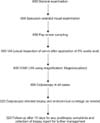1. Murthy NS, Juneja A, Sehgal A, Prabhakar AK, Luthra UK. Cancer projection by the turn of century-Indian science. Indian J Cancer. 1990; 27:74–82.
2. Shastri SS, Dinshaw K, Amin G, Goswami S, Patil S, Chinoy R, et al. Concurrent evaluation of visual, cytological and HPV testing as screening methods for the early detection of cervical neoplasia in Mumbai, India. Bull World Health Organ. 2005; 83:186–194.
3. Parashari A, Singh V, Sehgal A, Satyanarayana L, Sodhani P, Gupta MM. Low-cost technology for screening uterine cervical cancer. Bull World Health Organ. 2000; 78:964–967.
4. Coppleson M, Pixley EC. Colposcopy of cervix. In : Coppleson M, editor. Gynecologic oncology: fundamental principles and clinical practice. Edinburgh: Churchill Livingstone;1992. Vol. 1.
5. Parashari A, Singh V, Mittal T, Ahmed S, Grewal H, Gupta S, et al. Low cost technology for screening early cancerous lesions of oral cavity in rural settings. Ann Med Health Sci Res. 2014; 4:146–148.
6. Winkler JL, Tsu VD, Bishop A, Scott R, Sellors JW. Confirmation of cervical neoplasia using a hand-held, lighted magnification device. Int J Gynaecol Obstet. 2003; 81:35–40.
7. Denny L, Kuhn L, Pollack A, Wainwright H, Wright TC Jr. Evaluation of alternative methods of cervical cancer screening for resource-poor settings. Cancer. 2000; 89:826–833.
8. Sankaranarayanan R, Shastri SS, Basu P, Mahe C, Mandal R, Amin G, et al. The role of low-level magnification in visual inspection with acetic acid for the early detection of cervical neoplasia. Cancer Detect Prev. 2004; 28:345–351.
9. Aggarwal P, Batra S, Gandhi G, Zutshi V. Can visual inspection with acetic acid under magnification substitute colposcopy in detecting cervical intraepithelial neoplasia in low-resource settings? Arch Gynecol Obstet. 2011; 284:397–403.
10. Schneider A, Hoyer H, Lotz B, Leistritza S, Kuhne-Heid R, Nindl I, et al. Screening for high-grade cervical intra-epithelial neoplasia and cancer by testing for high-risk HPV, routine cytology or colposcopy. Int J Cancer. 2000; 89:529–534.
11. Mitchell MF, Schottenfeld D, Tortolero-Luna G, Cantor SB, Richards-Kortum R. Colposcopy for the diagnosis of squamous intraepithelial lesions: a meta-analysis. Obstet Gynecol. 1998; 91:626–631.
12. Olaniyan OB. Validity of colposcopy in the diagnosis of early cervical neoplasia: a review. Afr J Reprod Health. 2002; 6:59–69.
13. Sellors JW, Winkler JL, Kreysar DF. Illumination, optics, and clinical performance of a hand-held magnified visual inspection device (AviScope): a comparison with colposcopy. J Acquir Immune Defic Syndr. 2004; 37:Suppl 3. S160–S166.
14. Bang RA, Bang AT, Baitule M, Choudhary Y, Sarmukaddam S, Tale O. High prevalence of gynaecological diseases in rural Indian women. Lancet. 1989; 1:85–88.






 PDF
PDF ePub
ePub Citation
Citation Print
Print





 XML Download
XML Download